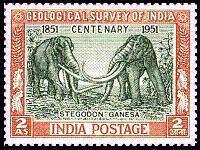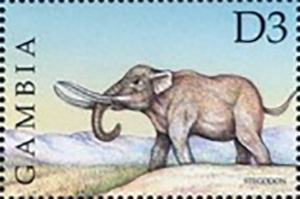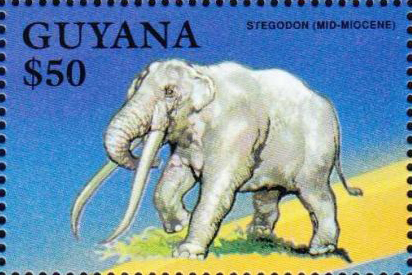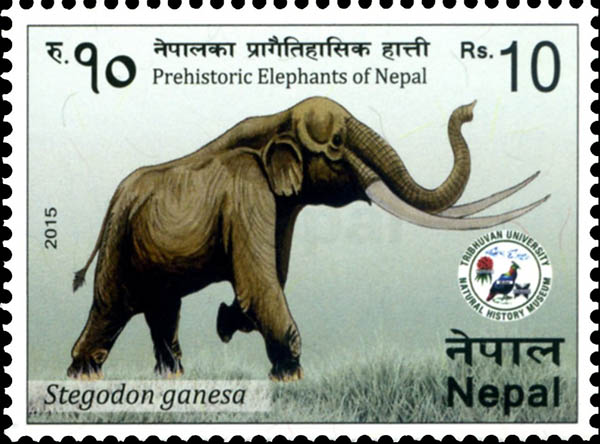Stegodon ganesha Faloner and Cautley, 1846

Phylum: Chordata Haeckel, 1874
Subphylum: Vertebrata Cuvier, 1812
Classe: Mammalia Linnaeus, 1758
Ordine: Proboscidea Illiger, 1810
Famiglia: Elephantidae Gray, 1821
Genere: Stegodon Falconer, 1847
Descrizione
Otto metri di lunghezza per un'altezza di quattro metri al garrese, con zanne di circa tre metri.
Diffusione
Gran parte dell'Asia durante il Pliocene, Pleistocene.
Bibliografia
–H. Falconer, P. T. Cautley. 1846. Fauna antiqua sivalensis. The fossil zoölogy of the Sewalik Hills in the north of India. London.
–G. H. R. von Koenigwald. 1956. Fossil mammals from the Philippines. Proceedings of the Pacific Science Congress, 339-361.
–H. O. Beyer. 1957. New finds of fossil mammals from the Pleistocene strata of the Philippines. National Research Council of the Philippines Bulletin, 41: 220-239.
–Y.-z. You, H.-y. Liu, and Y.-r. Pan. 1978. [Plio-Pleistocene deposits and mammalian faunas of Yuanmou Basin, Yunnan]. Professional Papers of Stratigraphy and Palaeontology, 7: 40-67.
–S. Sartono. 1979. The Discovery of a Pygmy Stegodon from Sumba, East Indonesia: An Announcement. Modern quaternary research in Southeast Asia, 5 (1979): 57-63.
–D. A. Hooijer. 1981. What, if anything new, is Stegodon sumbaensis Sartono?. Modern quaternary research in Southeast Asia, 6: 89-90.
–Diamond, Jared M. (1987). Did Komodo dragons evolve to eat pygmy elephants?. Nature. 326 (6116): 832.
–W. J. Sanders. 1999. Oldest record of Stegodon (Mammalia: Proboscidea). 19 (4): 793-797.
–G. D. van den Bergh. 1999. The Late Neogene elephantoid-bearing faunas of Indonesia and their palaeozoogeographic implications. A study of the terrestrial faunal succession of Sulawesi, Flores and Java, including evidence for early hominid dispersal east of Wallace's Line. Scripta Geologica, 117: 1-419.
–Shoshani, J.; Tassy, P. (2005). Advances in proboscidean taxonomy & classification, anatomy & physiology, and ecology & behavior. Quaternary International, 126-128.
–Yoshikawa, S; Kawamura, Y.; Taruno, H. 2007. Land bridge formation and proboscidean immigration into the Japanese Islands during the quaternary. Journal of Geosciences, Osaka City University. 50: 1-6.
–Van Den Bergh, G.D., Aweb, R.D., Morwoodc, M.J., Sutiknab, T., Jatmikob and Saptomo, E. W. 2008. The youngest stegodon remains in Southeast Asia from the Late Pleistocene archaeological site Liang Bua, Flores, Indonesia. Quaternary International, 182 (1): 16-48.
–Van Den Bergh, G. D.; Rokhus Due Awe; Morwood, M. J.; Sutikna, T.; Jatmiko; Wahyu Saptomo, E. (2008). The youngest Stegodon remains in Southeast Asia from the Late Pleistocene archaeological site Liang Bua, Flores, Indonesia. Quaternary International, 182 (1): 16-48.
–Samuel T. Turvey, Haowen Tong, Anthony J. Stuart and Adrian M. Lister (2013). Holocene survival of Late Pleistocene megafauna in China: a critical review of the evidence. Quaternary Science Reviews, 76: 156-166.
–Larramendi, A. (2016). Shoulder height, body mass and shape of proboscideans (PDF). Acta Palaeontologica Polonica, 61.

|
Data: 13/01/1951
Emissione: Centenario del Geological Survey of India Stato: India |
|---|

|
Data: 01/08/1999
Emissione: Animali preistorici Stato: Gambia |
|---|

|
Data: 10/08/1992
Emissione: Elefanti Stato: Guyana |
|---|

|
Data: 07/07/2015
Emissione: Elefanti preistorici del Nepal Stato: Nepal |
|---|